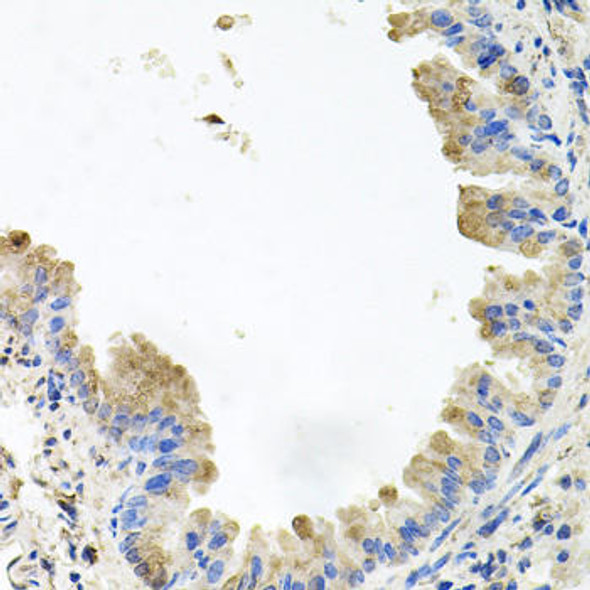Description
| Product Name: | PI3 Kinase p110 delta Rabbit mAb |
| Product Code: | CAB19742 |
| Size: | 20uL, 50uL, 100uL |
| Synonyms: | APDS, IMD14, P110DELTA, PI3K, p110D |
| Applications: | WB, IHC |
| Reactivity: | Human, Mouse, Rat |
| Host Species: | Rabbit |
| Immunogen: | A synthesized peptide derived from human PI3 Kinase p110 delta |
| Applications: | WB, IHC |
| Recommended Dilutions: | WB 1:500 - 1:2000 IHC 1:50 - 1:200 |
| Reactivity: | Human, Mouse, Rat |
| Positive Samples: | Mouse thymus |
| Immunogen: | A synthesized peptide derived from human PI3 Kinase p110 delta |
| Purification Method: | Affinity purification |
| Storage: | Store at -20°C. Avoid freeze / thaw cycles. Buffer: PBS with 0.02% sodium azide, 0.05% BSA, 50% glycerol, pH7.3. |
| Isotype: | IgG |
| Sequence: | Email for sequence |
| Gene ID: | 5293 |
| Uniprot: | O00329 |
| Calculated MW: | 119kDa |
| Observed MW: | 119KDa |
| UniProt Protein Function: | PIK3CD: Phosphoinositide-3-kinase (PI3K) that phosphorylates PftdIns(4,5)P2 (Phosphatidylinositol 4,5-bisphosphate) to generate phosphatidylinositol 3,4,5-trisphosphate (PIP3). PIP3 plays a key role by recruiting PH domain-containing proteins to the membrane, including AKT1 and PDPK1, activating signaling cascades involved in cell growth, survival, proliferation, motility and morphology. Mediates immune responses. Plays a role in B-cell development, proliferation, migration, and function. Required for B-cell receptor (BCR) signaling. Mediates B-cell proliferation response to anti-IgM, anti-CD40 and IL4 stimulation. Promotes cytokine production in response to TLR4 and TLR9. Required for antibody class switch mediated by TLR9. Involved in the antigen presentation function of B-cells. Involved in B-cell chemotaxis in response to CXCL13 and sphingosine 1-phosphate (S1P). Required for proliferation, signaling and cytokine production of naive, effector and memory T-cells. Required for T-cell receptor (TCR) signaling. Mediates TCR signaling events at the immune synapse. Activation by TCR leads to antigen-dependent memory T-cell migration and retention to antigenic tissues. Together with PIK3CG participates in T-cell development. Contributes to T-helper cell expansion and differentiation. Required for T-cell migration mediated by homing receptors SELL/CD62L, CCR7 and S1PR1 and antigen dependent recruitment of T-cells. Together with PIK3CG is involved in natural killer (NK) cell development and migration towards the sites of inflammation. Participates in NK cell receptor activation. Have a role in NK cell maturation and cytokine production. Together with PIK3CG is involved in neutrophil chemotaxis and extravasation. Together with PIK3CG participates in neutrophil respiratory burst. Have important roles in mast-cell development and mast cell mediated allergic response. Involved in stem cell factor (SCF)-mediated proliferation, adhesion and migration. Required for allergen-IgE-induced degranulation and cytokine release. The lipid kinase activity is required for its biological function. Isoform 2 may be involved in stabilizing total RAS levels, resulting in increased ERK phosphorylation and increased PI3K activity. Belongs to the PI3/PI4-kinase family. 2 isoforms of the human protein are produced by alternative splicing. |
| UniProt Protein Details: | Protein type:Carbohydrate Metabolism - inositol phosphate; Kinase, lipid; EC 2.7.1.153; Motility/polarity/chemotaxis Chromosomal Location of Human Ortholog: 1p36.2 Cellular Component: mast cell granule; plasma membrane; cytosol; phosphoinositide 3-kinase complex Molecular Function:protein binding; phosphatidylinositol-4,5-bisphosphate 3-kinase activity; 1-phosphatidylinositol-3-kinase activity; ATP binding; phosphoinositide 3-kinase activity; phosphatidylinositol-4-phosphate 3-kinase activity Biological Process: respiratory burst during defense response; phosphoinositide 3-kinase cascade; T cell activation; nerve growth factor receptor signaling pathway; natural killer cell activation; signal transduction; T cell receptor signaling pathway; protein amino acid phosphorylation; B cell receptor signaling pathway; B cell homeostasis; phosphoinositide phosphorylation; natural killer cell differentiation; phospholipid metabolic process; inflammatory response; T cell differentiation; epidermal growth factor receptor signaling pathway; neutrophil chemotaxis; adaptive immune response; phosphoinositide-mediated signaling; fibroblast growth factor receptor signaling pathway; B cell activation; mast cell chemotaxis; cytokine production; mast cell degranulation; phosphatidylinositol biosynthetic process; innate immune response Disease: Immunodeficiency 14 |
| NCBI Summary: | Phosphoinositide 3-kinases (PI3Ks) phosphorylate inositol lipids and are involved in the immune response. The protein encoded by this gene is a class I PI3K found primarily in leukocytes. Like other class I PI3Ks (p110-alpha p110-beta, and p110-gamma), the encoded protein binds p85 adapter proteins and GTP-bound RAS. However, unlike the other class I PI3Ks, this protein phosphorylates itself, not p85 protein.[provided by RefSeq, Jul 2010] |
| UniProt Code: | O00329 |
| NCBI GenInfo Identifier: | 67477424 |
| NCBI Gene ID: | 5293 |
| NCBI Accession: | O00329.2 |
| UniProt Secondary Accession: | O00329,O15445, Q5SR49, A6NCG0, G1FFP1, |
| UniProt Related Accession: | O00329 |
| Molecular Weight: | 119,479 Da |
| NCBI Full Name: | Phosphatidylinositol 4,5-bisphosphate 3-kinase catalytic subunit delta isoform |
| NCBI Synonym Full Names: | phosphatidylinositol-4,5-bisphosphate 3-kinase, catalytic subunit delta |
| NCBI Official Symbol: | PIK3CD |
| NCBI Official Synonym Symbols: | APDS; PI3K; IMD14; p110D; P110DELTA |
| NCBI Protein Information: | phosphatidylinositol 4,5-bisphosphate 3-kinase catalytic subunit delta isoform; PI3Kdelta; phosphoinositide-3-kinase C; PI3-kinase p110 subunit delta; ptdIns-3-kinase subunit p110-delta; phosphoinositide-3-kinase, catalytic, delta polypeptide variant p37d |
| UniProt Protein Name: | Phosphatidylinositol 4,5-bisphosphate 3-kinase catalytic subunit delta isoform |
| UniProt Synonym Protein Names: | Phosphatidylinositol 4,5-bisphosphate 3-kinase 110 kDa catalytic subunit delta |
| UniProt Gene Name: | PIK3CD |
| UniProt Entry Name: | PK3CD_HUMAN |






